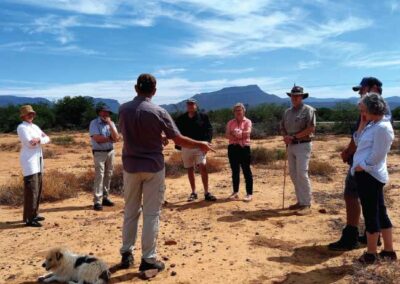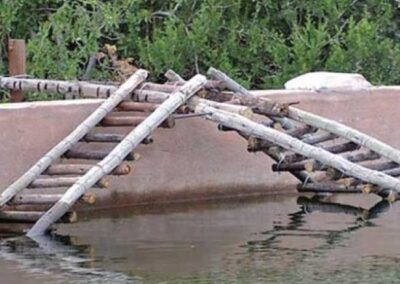Vulture-Safe Zones benefit biodiversity and people
Danielle du Toit, EWT Birds of Prey Programme
Southern African vulture populations are declining rapidly due to threats such as collisions with and electrocutions by electrical infrastructure, drowning in farm reservoirs, and of course, poisoning in all its many forms. Vulture Safe Zones have been established to address these issues and conserve vultures. Vulture Safe Zones are appropriately-sized geographic areas in which threats to the vulture species present are identified and mitigated through targeted conservation methods. They are established through active engagement with landowners and assistance through Vulture Safe Zone Alliance parties to create safe spaces for vultures to forage, roost and ultimately breed.1,2
Unintentional poisoning occurs when vultures ingest toxic contaminants, including veterinary pharmaceuticals still present in a carcass after treatment3,4, lead fragments in carcasses or entrails from lead ammunition5–8, and agrochemicals used illegally to kill so-called problem animals such as Black-backed Jackal or Caracal. Vultures are sometimes killed intentionally in a direct link to poaching. Sentinel poisoning is the action of vultures being killed due to their behaviour when feeding, which indicates the presence of a carcass of an animal which has been poached. Poachers sometimes poison these carcasses to provide themselves with more time to escape, as vultures die after feeding and do not provide signs to anti-poaching officials that there has been an incident. In traditional medicine, vultures are often killed for their body parts – namely the heads. Some cultures believe that by eating vulture heads and brains, one could be gifted with foresight9.
-

Herding Academy training day
-

The EWT's Danielle du Toit with Willem Wagener handing-over their Karoo Vulture Safe Zone signboard
Through the establishment of vulture safe zones, landowners and conservation organisations alike must address and ultimately remove all threats to vultures within the area, and although we identify these threats as they relate to vultures, they can negatively impact the health of the ecosystem and humans alike. For example, by using lead-free ammunition, meat harvested through hunting will not contain lead – a heavy metal proven to have serious health implications on those exposed to it, even in small amounts – and is thus healthier for humans to eat. Reservoirs fitted with safeguards to prevent drowning do not have to be drained every time an animal (such as a baboon or bird) drowns in it and contaminates the water supply, thus saving valuable water resources. By mitigating powerlines and energy infrastructure against collisions and electrocutions, we can save hundreds of other birds of dozens of species, not only vultures, and prevent or reduce power outages on these lines. When mitigating the threat of poisoning to vultures, we aim to assist landowners in using responsible non-lethal methods of predation management – which often goes hand in hand with a more hands-on approach to stock and land management. We aim to take a holistic approach – employing a decision-making framework rather than a single tool – to address livestock predation on properties.
Cattle herders are also crucial for the management of the predation of livestock. They are proven to not only be eliminate livestock losses to predators but, if following a grazing management plan, can also assist in regenerating otherwise unproductive soil and increasing ground cover. Simply put, increasing ground cover on otherwise barren landscapes reduces the impact of rainfall and allows the water to seep into the soil rather than run off and cause erosion. By implementing herding on properties, we can upskill and create employment opportunities for members of communities, as demonstrated by The SACT Herding Academy. By combatting desertification, landowners will be able to better withstand the effects of drought and build resilience to the impacts of climate change.10,11
-

Attendees at a lead ammunition-awareness day called Battle of the Bullets learning about the impacts of lead bullets on wildlife and people
-

Vulture-safe reservoir to prevent drownings and water contamination
The general market for agricultural products seeks sustainably and responsibly produced, traceable products12. By becoming Vulture Safe, a landowner can honestly present their practices and market to consumers while benefitting nature and the people around them. We encourage landowners and partners to use the Vulture Safe Zone logo for promoting their properties and products to generate interest and support for the cause and the landowners who are part of it. Vulture Safe Zones may focus on vultures, but they benefit all.
This work is made possible by the Charl van der Merwe Trust, IUCN Save Our Species Rapid Action Grant, Ford Wildlife Foundation, Alu-Cab, the Rupert Nature Foundation, and the Disney Conservation Fund
References:
- Mukherjee, A. & Galligan, T. H. Vulture Safe Zones to save Gyps vultures in South Asia Enhancing community-based vulture conservation in western lowlands of Nepal View project Vulture Safe Zone View project The Royal Society for the Protection of Birds. https://www.researchgate.net/publication/312315404 (2014).
- BirdLife International Vulture Safe Zone Fact Sheet.
- Plaza, P. I., Martínez-López, E. & Lambertucci, S. A. The perfect threat: Pesticides and vultures. Science of the Total Environment vol. 687 1207–1218 Preprint at https://doi.org/10.1016/j.scitotenv.2019.06.160 (2019).
- van Wyk, E., van der Bank, F. H., Verdoorn~, G. H. & Beans, H. CHLORINATED HYDROCARBON INSECTICIDE RESIDUES IN THE CAPE GRIFFON VULTURE (GYPS COPROTHERES). Camp. Btochem. Physiot vol. 104 (1993).
- Pain, D. J., Mateo, R. & Green, R. E. Effects of lead from ammunition on birds and other wildlife: A review and update. Ambio 48, 935–953 (2019).
- Gangoso, L. et al. Long-term effects of lead poisoning on bone mineralisation in vultures exposed to ammunition sources. Environmental Pollution 157, 569–574 (2009).
- Fisher, I. J., Pain, D. J. & Thomas, V. G. A review of lead poisoning from ammunition sources in terrestrial birds. Biol Conserv 131, 421–432 (2006).
- Garbett, R. et al. Association between hunting and elevated blood lead levels in the critically endangered African white-backed vulture Gyps africanus. Science of the Total Environment 630, 1654–1665 (2018).
- Ogada, D. L., Keesing, F. & Virani, M. Z. Dropping dead: Causes and consequences of vulture population declines worldwide. Ann N Y Acad Sci 1249, 57–71 (2012).
- LaCanne, C. E. & Lundgren, J. G. Regenerative agriculture: Merging farming and natural resource conservation profitably. PeerJ 2018, (2018).
- Gosnell, H., Gill, N. & Voyer, M. Transformational adaptation on the farm: Processes of change and persistence in transitions to ‘climate-smart’ regenerative agriculture. Global Environmental Change 59, (2019).
- Responsible Wool Standard (RWS) – Textile Exchange.
